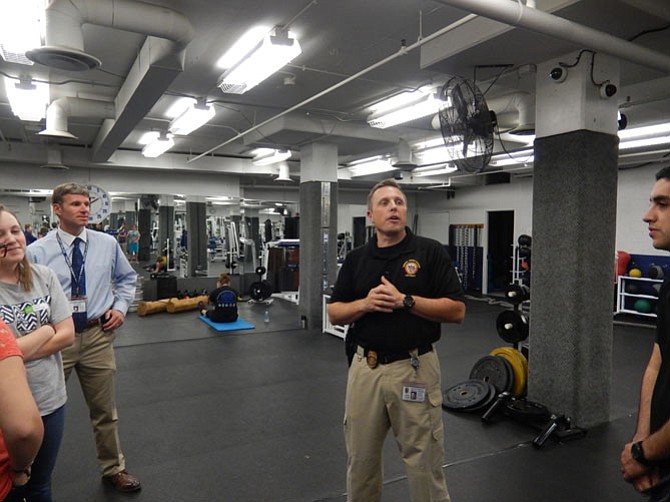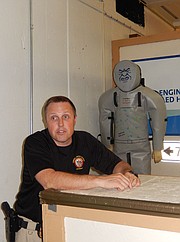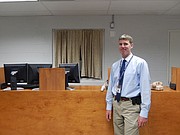Lt. Todd Kinkead (on left) and Mountain View grad Leo Becerra (on right) listen to Lt. Mike Shamblin discuss how officers train in the gym. Photo by Bonnie Hobbs.
Centreville — About 30 local residents recently got a behind-the-scenes look at the Fairfax County Criminal Justice Academy. They learned what recruits go through to become police officers and participated in a training scenario.
Held June 10, it was sponsored by the Sully District Police Station and its Citizens Advisory Committee. “Tonight is to let you see what we, as police officers, deal with,” said the station’s assistant commander, Lt. Matt Owens.
The Criminal Justice Academy opened in 1985 in an elementary school in Annandale. Then in 1996, officers began using their current, more modern facility in Chantilly. Lt. Mike Shamblin, a supervisor in the Law Enforcement Training Unit, has worked in the academy for more than 22 years.
“We train officers for the Fairfax County Police Department, Sheriff’s Office, the towns of Herndon and Vienna, the Fire Marshal’s Office and Animal Control,” he said. “This facility is dually run by police and sheriff personnel. We do basic training for all recruits. The Law Enforcement Training Unit trains the entire Police Department, and the Sheriff’s Office runs in-service training and keeps track of everyone’s certifications.”
Normally, about 40 people are in a recruit class. But in-service training for topics such as first aid and CPR is also held at the academy. Officers attend, as well, to requalify for skills such as handcuffing and using a baton, Taser and pistol; some are also rifle- or shotgun-qualified there.
“The Virginia Department of Criminal Justice Services [DCJS], headquartered in Richmond, is responsible for the standards of training within the state,” said Shamblin. “It certifies and [confirms] police powers on the officers and maintains all training records.”
All officers must meet 1,370 DCJS training objectives dealing with professional and legal matters, communications, patrol, investigations, defensive tactics, weapons use, plus driver, physical and field training. And it involves both written and practical-experience tests.
Fairfax County officers also receive training beyond what the state mandates. Those attending the academy must learn and master an additional 172 Criminal Justice Academy training objectives, for a total of nearly 1,550 objectives. These extra objectives include, for example, completing a half-mile timed run in less than 4 minutes and running an obstacle course in 1 minute, 20 seconds. Both these skills are related to finding and apprehending a suspect.
“We do 26 weeks of training, including legal exams, spelling tests and a DCJS final exam,” said Shamblin. “Officers also receive two weeks each pistol and firearms training — both night and day — plus driver training. They learn defensive tactics with their bodies. They’re also exposed to pepper spray — and then have to talk on the police radio and run through an obstacle course to show you can run through the spray. We do this because, when police use it, some of it blows back on them, too.”
Physical fitness includes running and strength training. Driver training includes practical exercises, such as driving on slippery surfaces and correcting a vehicle after driving off the road. And on the driving track, officers learn how to handle their cars and not lose control even when traveling at speeds up to 107 mph.
“We also require on-the-job field training, running through various scenarios an officer could face,” added Lt. Todd Kinkead, who heads the Sully District Station’s Criminal Investigations Section. And every two years, the state requires officers to be retrained to maintain their certification.
“Some people wash out,” said Shamblin. “It’s a reality check when you get outside and realize people actually want to hurt you.”
The residents then toured the facility, including the gym. Painted in large letters on the walls are the words, “Police, don’t move” and “Training is everything.” And on staff is a physical therapist to rehabilitate officers who’ve been injured. “She’s rehabbed me several times,” said Kinkead. “She’s a phenomenal resource.”
There’s a black-walled room where officers can get used to being outside at night with their blue, cruiser lights flashing. And another room has mats on the floor and a dummy for police to tackle and subdue with their weak hands — i.e., their left hands, if they’re right-handed.
In a room called the “maze,” officers practice clearing a room and searching a building without getting shot. There’s also an area set up like an apartment, also for searching, with doors on each side of a long hall. “It’s an absolutely miserable place to search,” said Shamblin. “It’s horrible because there are so many doors.”
In addition, there’s a practical-exercise area resembling a section of a town where officers may run different scenarios. In it, they respond to pretend calls for help at various businesses, such as a bank, restaurant, pizza parlor, bar, sporting-goods store, quick mart and a thrift shop, plus a park.
And during the tour, residents who wanted to get a better idea of the danger officers face every day got to participate in several, different scenarios in the “bar.” Individually, volunteers assumed the role of a police officer responding to a call for a “disturbance,” but received no other information before heading inside. So they had no idea how many people were involved, exactly what led up to the incident and whether anyone had a weapon.
Armed with a pretend gun in a holster, the “officer” entered the “bar” and encountered two men fighting. The “officer” then had to quickly assess the situation, decide what was going on and whether or not to draw his or her weapon before the “officer” or someone else got hurt or “killed.”
After each scenario, MPO Nancy Cottrell explained to the volunteers what they should or shouldn’t have done in each scenario, and why. “We appreciate you guys coming out and learning,” she said. “You can be a big help by getting involved [when you see something amiss] by calling us and providing us with good information.”
June Mountain View High grad Leo Becerra — who hopes to eventually attend that academy and become a police officer, himself — then expressed gratitude on behalf of the residents. “Thank you, guys, for giving us this opportunity and opening up our eyes to what you do every day,” he said. “I know we don’t thank you enough, but we really do appreciate it.”




